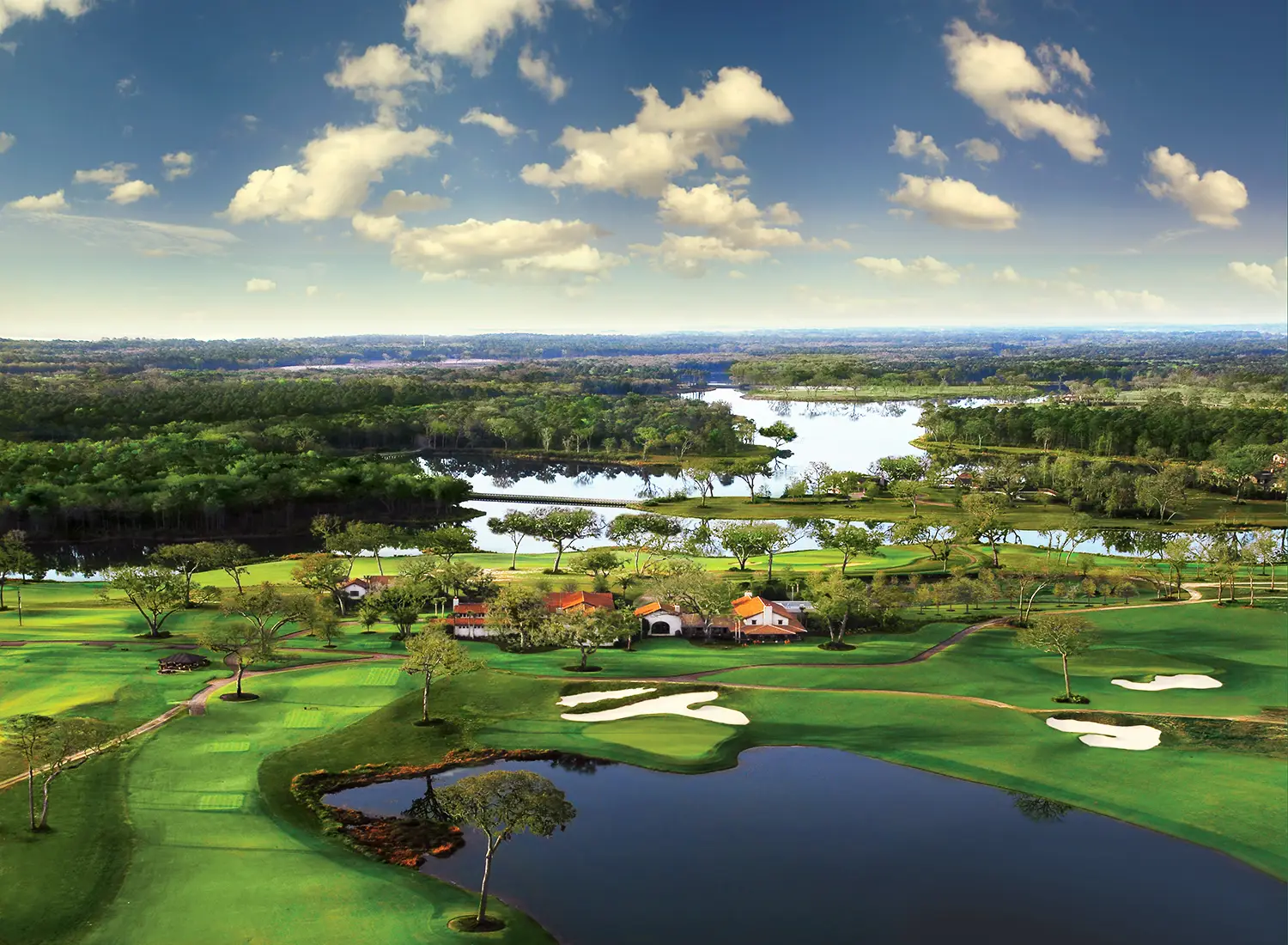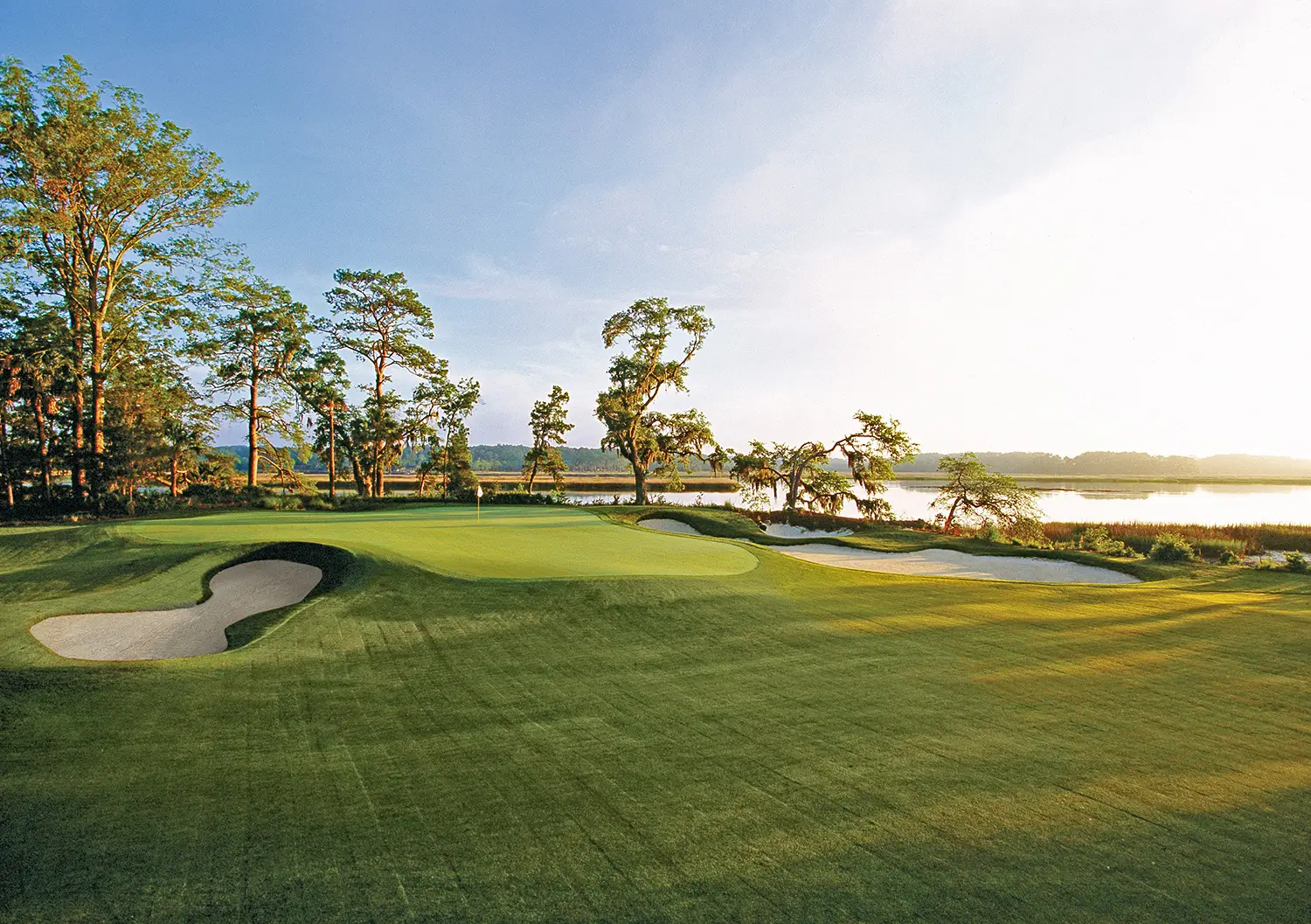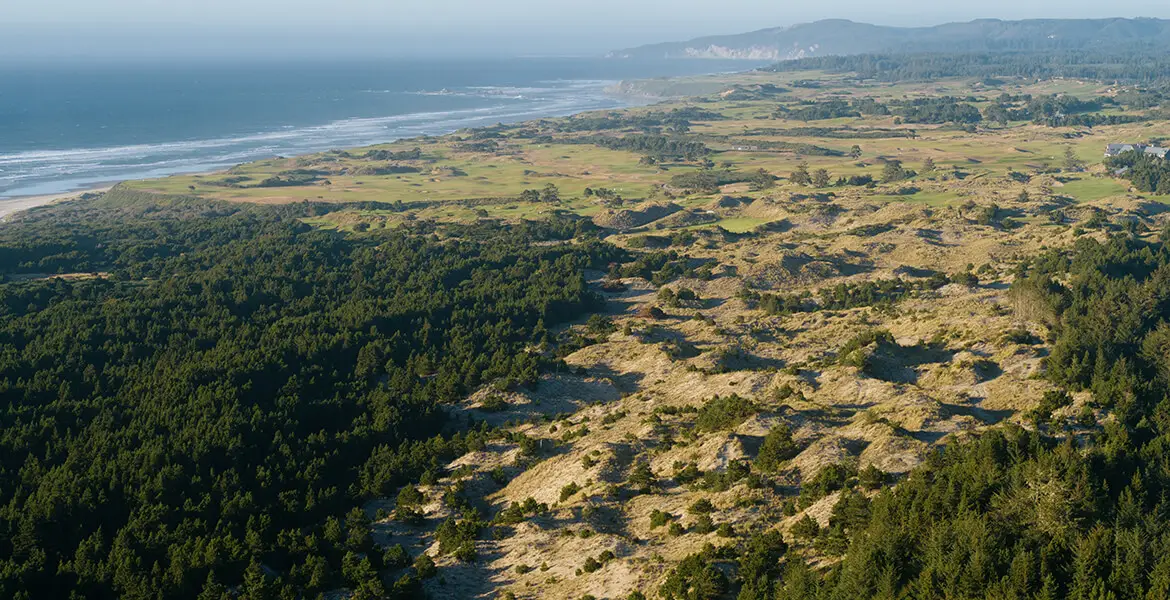Tiger Woods donned his fourth Green Jacket. The U.S. Open returned to Pinehurst No. 2. Tiger lifted the Claret Jug again at the Old Course. And Phil Mickelson won the PGA Championship, his second major, on a Monday finish at Baltusrol.
Yes, 2005 was a good year for golf. But one could argue it was an even better year for golf course design.
Twenty years ago, a slew of new courses opened around the world—some of which have earned bucket-list status, while others have built out memberships that include some of the world’s best professionals. Here, we take a closer look at 10 exceptional venues that celebrate 20 great years (and counting) in 2025.

Bandon Trails—Bandon, Ore.
When Bill Coore and Ben Crenshaw set out to create the third course at Bandon Dunes Golf Resort, they knew they had their work cut out for them. Unlike the first two championship-caliber courses, which play out to and along precipitous cliffs abutting the Pacific Ocean, their 6,788-yard layout carved its way through the property’s temperate forest almost three-quarters of a mile inland. “The goal was to build a course that somehow would be able to measure up,” says Coore, “at least to the point of being considered a complement to golf at Bandon Dunes, but also to be a complement to that site and reflect what that site is about.”
Some will never rank Bandon Trails above the others (it ranks No. 97 in The LINKS 100—one of three of the resort’s courses to make the list—between Pacific Dunes at No. 42 and Bandon Dunes at No. 99) for the simple fact that the course doesn’t offer the same dramatic, oceanfront vistas. Others will conclude that Bandon Trails’s routing through the conifer trees authentically roots it in the Pacific Northwest. All Coore knows is that the course’s contribution to the other designs firmly positions Bandon Dunes in a class by itself. “At Bandon, you can sit there and listen to people talk about five golf courses, and each one has its own following,” he says. “I just know of no other place in the world like it.”

Barnbougle Dunes—Bridport, Australia
When Barnbougle Dunes opened 20 years ago, Australia’s first true links course—as its creator, Tom Doak, likes to point out—immediately served as a testament to the rugged appeal of that classic, seaside golfing experience. The outward nine plays through a series of saddles amongst 40-foot-high dunes that provide some buffer from the wind, while also dictating shot shapes. The returning nine plays atop rolling contours with views of the Bass Strait. Both sides feature short par fours that some have deemed to be the most interesting of the layout. At the very least, they’re poster children for the fact that the course was designed to reward strategic thinking from tee to green. It debuted at No. 22 in The LINKS 100.

We-Ko-Pa Golf Club (Saguaro)—Fort McDowell, Ariz.
By the mid-2000s, thanks to several noteworthy design projects under their belts, Coore & Crenshaw were becoming hot commodities, so much so that the mere utterance of their names elicited plenty of excitement whenever they were attached to a new course development. The duo furthered that reputation when the Saguaro course opened at We-Ko-Pa in 2005. With generously wide fairways and tee boxes, and greens strategically positioned near one another, the course is easily walkable, while also tracing the natural movement of the land and providing 360-degree views of four surrounding mountain ranges.

Whisper Rock Golf Club (Upper)—Scottsdale, Ariz.
A few years after Whisper Rock’s grand opening, which unveiled Phil Mickelson’s first foray into golf course design (his Lower course opened for play in 2001), Tom Fazio set out to build a second 18-hole championship-caliber course at the exclusive Scottsdale club, one that was originally intended to be a stern test for the club’s growing membership of low-handicap and PGA Tour players. He accomplished the feat by positioning the back tees in locations that require players to hit drives on demanding lines to fairways that angle away from them. To make the course enjoyable for everyone else, Fazio emphasized generous landing areas and designed green complexes with lots of chipping areas that provided options for recovery. At certain times during a round, however, golfers may struggle to notice these features, only because the course masterfully winds its way through picturesque Sonoran Desert landscapes, not to mention a series of imposing granite boulder formations.

Frederica Golf Club—St. Simons Island, Ga.
On St. Simons Island just off the southern coast of Georgia, Sea Island Resort gets the lion’s share of exposure. In fact, about a dozen PGA Tour players all call the community home. That doesn’t mean the resort’s Seaside, Plantation, or Retreat courses are where they spend most of their time. Instead, many of the island’s Tour pros venture north to Frederica, which is known for its extensive practice facilities—a training ground that is unrivaled in the area. Of course, the Tom Fazio-designed golf course isn’t too shabby, either. Covering more than 300 acres, the layout was conceived with the help of Sir Michael Bonallack of the Royal and Ancient Golf Club of St. Andrews, and while the links courses in the Scottish county of Fife are known for their minimalist nature, such is not the case at Frederica. In short, Fazio and his team moved seven million cubic yards of soil to create what is now the highest ridge in Georgia’s Glynn County. Additionally, more than 1,100 live oaks were transplanted to the site and now reside across the 7,218-yard course’s series of dunes and ridges.

Wynn Golf Club—Las Vegas, Nev.
Steve Wynn and Tom Fazio initially collaborated in the Las Vegas desert in 1990, moving millions of cubic yards of earth to create a spectacular golfing oasis—no matter the cost—at Shadow Creek. Fifteen years later, the duo was back at it, with a similar mindset, as they cleared the land that had previously held the Desert Inn Golf Club. In its place, Wynn and Fazio created the developer’s eponymous golf club just steps from the bustling Vegas Strip.
During the 6,722-yard layout’s redesign in 2019 (which dropped the course to par 70), more than 400,000 cubic yards of earth were moved and shaped across the property’s 129 acres to create eye-catching ridges and valleys. Those topographical manipulations, combined with the design team’s preservation of 100,000 shrubs and 7,000 mature trees, create a sense of isolation on each hole. If it weren’t for the resort and casino towers, which rise above the tree line and frame some of the fairways, players during their rounds might easily forget that they are only 500 yards from Las Vegas Boulevard.

May River Golf Club—Bluffton, S.C.
Jack Nicklaus the course designer, like several other prominent architects, conjures up mixed reactions among avid golfers. While he has his detractors, most architecturally minded golfers will agree that the May River represents one of his strongest creations. As it flows through the front nine and into the back, the course’s difficulty gradually increases, so it should come as no surprise to players that the 550-yard par-five 18th hole is defined by two prominent hazards—a pond that guards much of the right side of the fairway and a majestic, albeit imposing, centuries-old live oak tree that blocks players who play it too safe down the left side of the hole. The course, which meanders through the May River Forest, is also certified by Audubon International as a Cooperative Sanctuary, which means it not only provides pristine playing conditions but also protects the natural habitats of numerous species of wildlife that live on or adjacent to the course.

Sandy Lane (The Green Monkey)—St. James, Barbados
You could argue that Barbados began to emerge as a Caribbean golfing destination in 1995 with the opening of Royal Westmoreland Golf & Country Club. That development picked up steam by the early 2000s when Sandy Lane, a boutique, 113-room luxury resort, opened alongside the first of its two Tom Fazio-designed golf courses. What really put Barbados on the Caribbean golfing map, however, was Fazio’s return a few years later to build the Green Monkey, an ultra-exclusive track created as an amenity only for Sandy Lane’s resort guests. The course plays across a parcel of land that previously was used as a mine to extract the material necessary to build all of the roads on the island. That bold terrain was made even bolder, as Fazio carved the quarry’s cliff sides into straight limestone walls. According to Tom Marzolf, the senior design associate with Fazio Design, the course carried a $27 million price tag.
Boston Golf Club—Hingham, Mass.
Although Gil Hanse could claim almost 10 original designs prior to his work creating Boston Golf Club (BGC), it was this 7,105-yard routing through the deciduous forest of southeastern Massachusetts that established the architect’s reputation. In fact, Hanse’s appreciation for the minimalist look of some of the British Isles’s most celebrated courses resonated perfectly with BGC’s founders, who were looking to create a destination that offered an “old world” golf experience—one that reflected the values of the game as it had been played during golf’s golden age.
At several points during a round at BGC, members and guests will encounter specific holes and design features that reflect that British Isles inspiration. The 12th hole, for example, requires players to hit a blind tee shot over a stone wall, using a small separation in that wall as an aiming point. They’ll later face a “valley of sin” that dooms all approach shots that come up short of the green. The 16th hole also features a “Principal’s Nose” bunker modeled after a more famous 16th hole across the pond—that of the Old Course at St. Andrews.
Champions Retreat—Evans, Ga.
The genesis of Champions Retreat can be traced back to the Champions Dinner at the Masters in 1999, when Gary Player recruited Arnold Palmer and Jack Nicklaus to join him in designing 27 holes at a private club just down the street—one that was initially developed by a fellow South African businessman. Up until then, the three Hall of Famers had never collaborated on a course together, and no property boasted layouts designed by all three of them. “With all of the golf courses that we built in our individual companies, which must be over 600 between the three of us,” Player says, “there’s no other place where you have a course that we designed together.”
Comprised of three distinct parcels of land—appropriately named Island, Creek, and Bluff—the site provided all three Masters champions with distinctive canvases upon which to work. “We each tried to outdo each other, obviously, to see who had the best golf course,” Player affectionately remembers. “That was the challenge. It was that competitive spirit that we had all our lives.” Incidentally, all three created holes that, in different ways, bear a resemblance to Augusta National, whether it’s via rolling fairways lined with tall Georgia pines or holes bisected by meandering creeks. Since 2019, Champions Retreat has hosted the first two rounds of the prestigious Augusta National Women’s Amateur on its Island and Bluff nines, determining which players (the leading 30 and ties) advance to the final round at Augusta National. It’s all a fitting tip of the cap to where and how Champion Retreat first came into focus.






